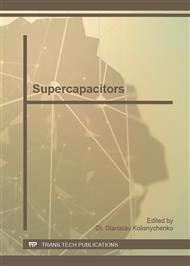p.385
p.394
p.399
p.406
p.410
p.415
p.420
p.427
p.431
Preparation and Electrochemical Characterization of an Activated Carbon Material of High Surface Area for Supercapacitor
Abstract:
A low-cost organic compound mainly comprising of polyarylate was selected as precursor and a chemical activation method was used to prepare an activated carbon material of large surface area, with which the activated carbon electrodes of high specific capacitance were fabricated for supercapacitor. Impact of activating temperature on the specific capacitance of activated carbon electrode was studied, the relationship between the pore structure, surface area and specific capacitance of activated carbon electrode were discussed. The specific capacitance and ESR (equivalent series resistance ) of the electrode fabricated with the activated carbon prepared at 700°C is 211F.g-1 and 0.2Ω/cm2 in hydrous electrolyte and the 122F/g and 1Ω/cm2 in orgnic electrolyte respectively. Because of the different ion diameter in orgnic and hydrous electrolyte, activated electrode show different electrochemical behavior in cyclic voltammetry examinations.
Info:
Periodical:
Pages:
410-414
Citation:
Online since:
February 2012
Authors:
Price:
Сopyright:
© 2012 Trans Tech Publications Ltd. All Rights Reserved
Share:
Citation:



